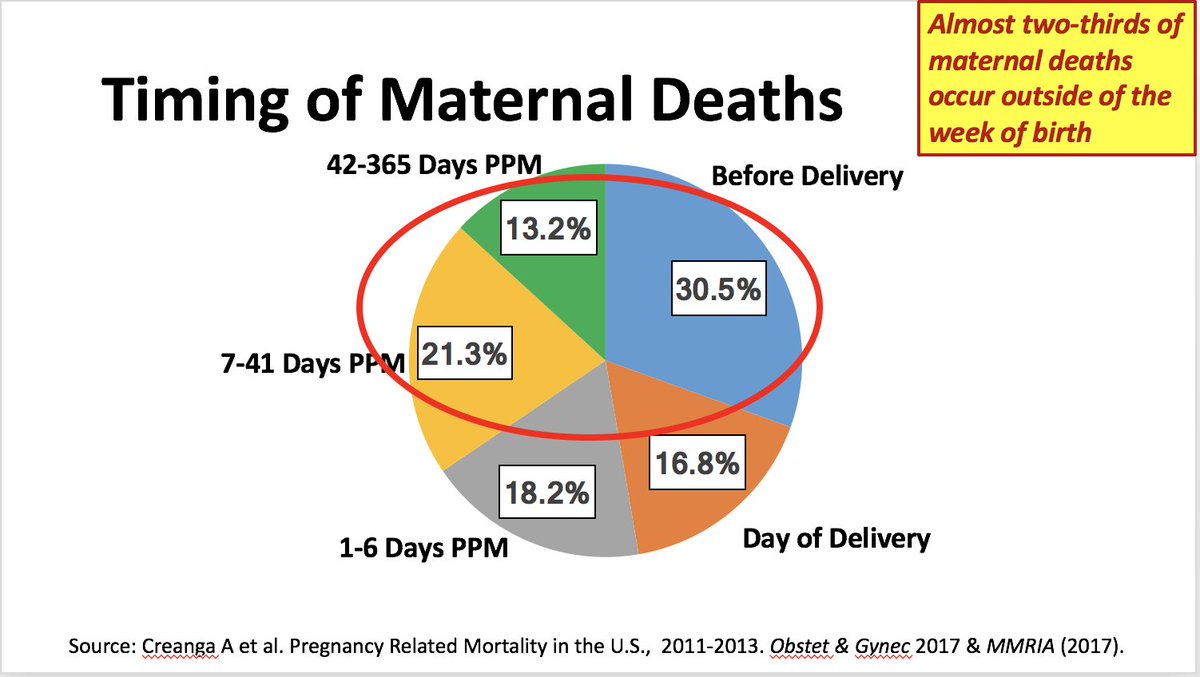1/ Public image of maternal death is a woman who, in dramatic moments immediately surrounding birth, suffers terrible tragedy
latest @CDCgov data tells different story...rather than waiting to publish academic paper, decided to share analysis right away
latest @CDCgov data tells different story...rather than waiting to publish academic paper, decided to share analysis right away
https://twitter.com/statnews/status/1032251123816706049
2/ first of all, > 80% maternal death does not occur on the day of delivery... >60% does not even occur within a week of delivery
The great majority of these deaths are at home or in the community...NOT in the hospital
(slide by @BirthNumbers)
The great majority of these deaths are at home or in the community...NOT in the hospital
(slide by @BirthNumbers)

3/ second, causes of maternal death shifting...deaths due to acute pregnancy conditions (hypertension, hemorrhage) have been declining for decades
meanwhile, deaths due to chronic conditions, particularly mental health on the upswing
meanwhile, deaths due to chronic conditions, particularly mental health on the upswing

4/ and most shockingly...rates of death are increasing for ALL reproductive age women, not just those who are pregnant
since 2010, death rate for ALL women age 15 to 45 jumped by 14%
...for women age 25 to 34 jumped by 20% 🚨
since 2010, death rate for ALL women age 15 to 45 jumped by 14%
...for women age 25 to 34 jumped by 20% 🚨
5/ here's what these means about our approach to fixing it...
if we only focus on hospitals, we will miss a critical opportunity (probably most of the opportunity) to save mothers lives--it's equally important that we focus on our communities
if we only focus on hospitals, we will miss a critical opportunity (probably most of the opportunity) to save mothers lives--it's equally important that we focus on our communities

6/ can be hard to wrap our minds around what investing in communities means concretely but I've long wondered...
there are many lists of best city to retire in...why no lists of best city to be born in? how can we define what this even means?
there are many lists of best city to retire in...why no lists of best city to be born in? how can we define what this even means?
https://twitter.com/ariannahuff/status/733667420775288834
7/ @nycgov recently demonstrated how investment from a city in the wellbeing of mothers can make a difference...
www1.nyc.gov/office-of-the-…
www1.nyc.gov/office-of-the-…
8/ adding to the potential of cities, parishes and other platforms of community to transform the wellbeing of mothers...
the majority of preventable deaths are rooted in lack of broader failures of social support, not necessarily unsafe medical care
the majority of preventable deaths are rooted in lack of broader failures of social support, not necessarily unsafe medical care
https://twitter.com/neel_shah/status/962043225409126402
9/ finally - we can’t solve the problem of maternal deaths unless we acknowledge that women’s health isn’t something to be concerned about only during pregnancy and then disregarded after the baby is born
10/ state policies that expand Medicaid coverage for women only during pregnancy and then drop them 60 days after giving birth are exhibit A of the bigger picture problem cc: @jamie_daw ncbi.nlm.nih.gov/pubmed/28373324
11/ Once we focus on the health of all reproductive-age women, we’ll see that the current concern with deaths during pregnancy was the equivalent of a canary in a coal mine warning of a much larger problem 

🤔of the day for public access 📺
latest data suggests solution to #maternalmortality 👉
less about heroically rescuing women from calamitous event
MORE about steadily supporting during vulnerable period that extends well before and after birth itself
latest data suggests solution to #maternalmortality 👉
less about heroically rescuing women from calamitous event
MORE about steadily supporting during vulnerable period that extends well before and after birth itself

• • •
Missing some Tweet in this thread? You can try to
force a refresh




